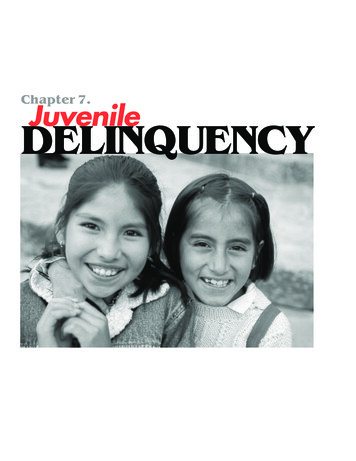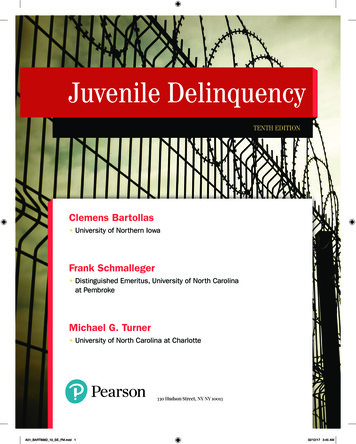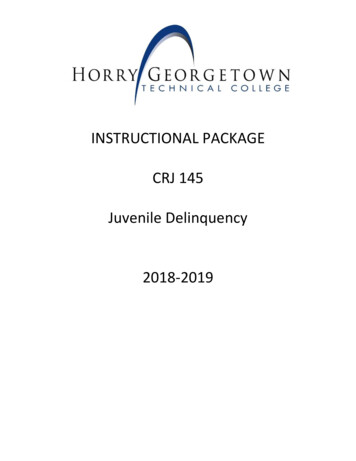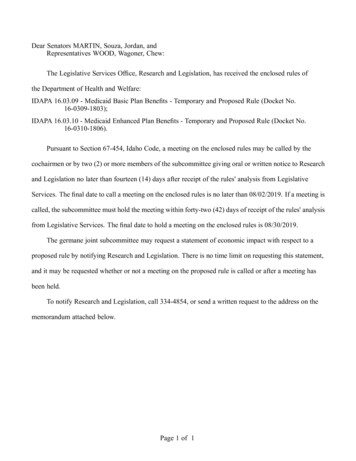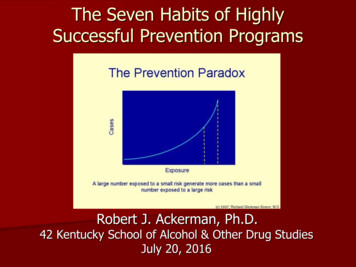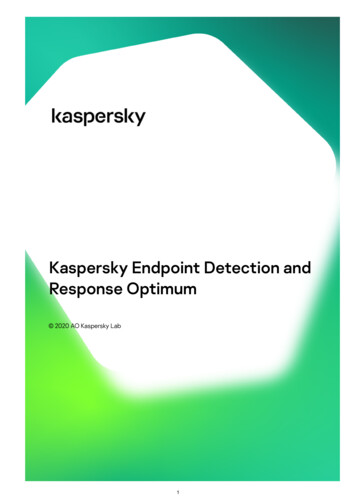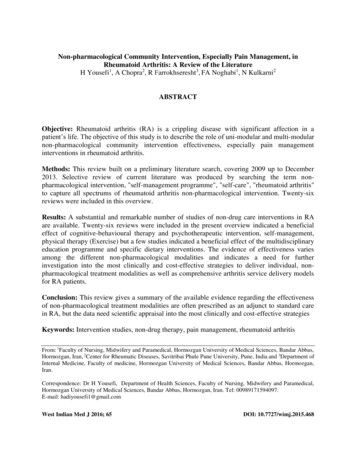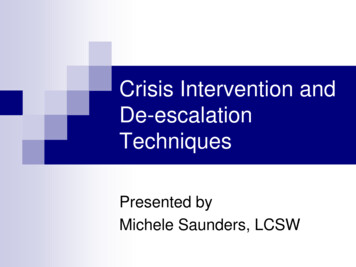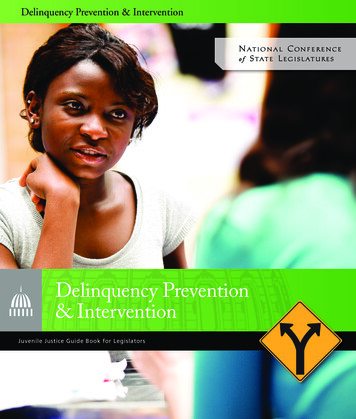
Transcription
Delinquency Prevention & InterventionDelinquency Prevention& InterventionJuvenile Justice Guide Book for Legislators
Delinquency Prevention & InterventionIntroductionEngaging in delinquent behavior can lead to drug use anddependency, dropping out of school, incarceration, adultcriminal behavior and injury. Early intervention and preventionof delinquent behavior can divert juveniles from the adverseconsequences that can result from delinquency.Risk and Protective FactorsThere are identified risk factors that increaserejection are identified as risk factors. School anda juvenile’s likelihood to engage in delinquentcommunity risk factors include failure to bond tobehavior, although there is no single risk factorschool, poor academic performance, low academicthat is determinative. To counteract these riskaspirations, neighborhood disadvantage, disorganizedfactors, protective factors have also been identifiedneighborhoods, concentration of delinquent peerto minimize a juvenile’s likelihood to engage ingroups, and access to weapons. Many of these riskdelinquent behavior.factors overlap. In some cases existence of one riskThe four areas of risk factors are: individual, family,peer, and school and community. Individual riskGenerally, protective factors—such as positive schoolfactors include early antisocial behavior, poorattendance, positive social orientation or the abilitycognitive development, hyperactivity and emotionalto discuss problems with parents—are a buffer tofactors, such as mental health challenges. Familyminimize or moderate the effect of risk factors andrisk factors include poverty, maltreatment, familytheir ability to bring about delinquent behavior.violence, divorce, parental psychopathology,Protective factors seem to mitigate the influence of riskfamilial antisocial behaviors, teenage parenthood,factors. Both risk and protective factors are discussedsingle parent family and large family size. Peeras part of delinquency prevention and intervention.factors of association with deviant peers and peer2factor contributes to existence of another or others.
Juvenile Justice Guide Book for LegislatorsRisk FactorsThere are four identified risk factors thatGenerally, protective factors—increase a juvenile’s likelihood to engage insuch as positive school attendance,delinquent behavior.1234Individual risk factorsFamily risk factorspositive social orientation or theability to discuss problems withparents—are a buffer to minimizeor moderate the effect of riskfactors and their ability to bringPeer risk factorsabout delinquent behavior.School and Communityrisk factors3
Delinquency Prevention & InterventionPhases of Preventionand InterventionDelinquency prevention and intervention effortspercent, adult arrest by 27 percent and violentprimarily are comprised of identifying the risk factorscrime by 29 percent. Other studies have shown thatthat contribute to delinquency, addressing thoseviolence begets more violence. One study showedfactors early, and building on protective factors tothat children who were victims of violence were 24offset the risks. Although traditional delinquencypercent more likely to report engaging in violence.prevention policies were targeted at school-ageOne-third of the victims of child abuse or neglectyouth, more modern delinquency prevention andare likely to subject their own children to abuse. Inintervention efforts focus on pre-birth into childhoodcases of extreme exposure to violence, children mayand adolescence.develop post-traumatic stress syndrome, which makesit more difficult to form appropriate relationships,cause an increased tolerance for violence and lead toThe most recent research suggestsdifficulty learning new information.that the earliest prevention shouldQuality early child care and education provide thebegin in the womb and in the firstbases for healthy growth and development, whichyears of a baby’s life.includes physical well-being and structured earlylearning and educational opportunities. Nutrition,health care, parental involvement and interaction,Pre-natalFor instance, research on brain development showsthat neural connections regulating responses to stressare formed in utero and into the first 33 months oflife (as noted in the “Adolescent Development andand quality pre-school experiences also contribute.Positive early child care includes adequate staffqualifications and training, low staff-to-childratios, adequate staff compensation anddevelopmental curriculum.Competency” section). A child who grows up in achaotic or abusive environment is more likely to havean over-reactive flight-or-fight reflex. Furthermore,During the pre-teen years,someone who cannot maintain self-control underthe strongest risk factor forstress has a greater inclination to violence.delinquency is influence froma delinquent peer group.Early ChildhoodSocial research has shown a strong associationbetween childhood abuse and neglect and delinquentbehavior. A National Institute of Justice studyshowed that a history of child abuse and neglectincreased the likelihood of juvenile arrest by 594School AgeThe next crucial phase of prevention andintervention occurs during the pre-teen years. During
Juvenile Justice Guide Book for Legislatorsthis time, the strongest risk factor for delinquencyfurther shows that therapeutic programs—such asis influence from a delinquent peer group. Otherrestorative programs, programs centered on skillprominent risk factors for school-age children arebuilding, and counseling—were more effective thaninvolvement of family members in crime, academicdisciplinary or deterrence philosophies. It is importantfailure and disinterest in school, family violence, drugthat the program type match the youth’s needs.use, and gang influence and membership.Schools play a particularly important role duringthe school-age years. They provide a forum withinResearch by the Peabody Researchwhich to promulgate programs and policies alignedInstitute (2010) shows, in general,with delinquency prevention and intervention. Thesethat intervention for high-riskprograms can address a range of topics, such as drugdelinquents, on average, moreand alcohol use, bullying, and gang prevention.effectively reduces recidivism thanIn fact, most gang resistance programs are schoolbased. The school role also includes their discretionin disciplining and reporting juveniles, sometimeswhen those interventions areapplied to low-risk delinquents.resulting in delinquency proceedings.Evidence-Based ProgramsDuring this time, the strongest riskModel prevention evidence-based programs suchfactor for delinquency is influenceas multi-systemic therapy (MST) and familyfrom a delinquent peer group.functional therapy (FFT) have shown positive effectson recidivism. MST is a family systems approachdesigned to help parents deal effectively with theirchild’s behavior problems. It is provided in theRisk/Needs AssessmentsResearch shows the most effective interventionsare those that target the right kids. Research bythe Peabody Research Institute (2010) shows, ingeneral, that intervention for high-risk delinquents,on average, more effectively reduces recidivism thanwhen those interventions are applied to low-riskdelinquents. Practically, juvenile justice systems willhave more success in reducing recidivism if they focusinterventions on higher-risk youth. The researchhome, school and other community locations. FFTtargets youth with substance abuse, delinquency orviolence in their home environment. It focuses onimproving the function of the family by increasingproblem-solving skills and emotional connectionsand providing appropriate parental structure forchildren in the home. Many states, includingPennsylvania, Florida and Washington, haveimplemented evidence-based programs. Researchalso has shown the effectiveness of smaller, local5
Delinquency Prevention & Interventionprograms that follow principles similar to theseage range within which students may be classified assuccessful programs.truant. In general, research shows that truancy is arisk factor for other behaviors such as substance andIntervening with Status OffendersStatus offenses are non-criminal behaviors thatconstitute an offense only because the juvenilesare minors. The most common status offenses aretruancy, curfew violations, running away and alcoholalcohol use, dropping out of school, and involvementin the juvenile justice system. However, researchconducted by Huizinga et al. also indicates that,although truancy can be a factor associated withdelinquency, it is much less so than factors such asviolations. Preventing and providing structured andsubstance abuse or mental health problems.appropriate services for status offenders are key toWhen the federal Office of Juvenile Justice andpreventing future delinquency.Many youth service experts recommend thatstatus offenders benefit from assessment and earlyintervention for family problems, as opposed to adisciplinary focus and adjudication. These providersadvocate organized, early assessment by communitycenters in collaboration with local agencies. TheDelinquency Prevention (OJJDP) evaluated sevennational truancy reduction programs, it identifiedfive elements of effective programs: parentalinvolvement, a continuum of services, a collaborativeeffort (with law enforcement, mental health,mentoring and social services), school administrativesupport and commitment, and ongoing evaluation.community centers identify the needs of andprovide the necessary services for the juveniles—and their family members, if necessary—to help.although truancy can be aprevent delinquency.factor associated with delinquency,it is much less so than factors suchStatus offenses are non-criminalbehaviors that constitute anas substance abuse or mentalhealth problems.offense only because the juvenilesare minors.Traditionally, habitual truants were suspended,expelled, and often referred to juvenile courts orthe child welfare system. Now, research suggestsTruancyTruancy is absence from school that is not excused bythe school or a parent; some states provide a statutorythat punitive policies only increase the likelihood ofschool dropouts. Studies suggest that the “positiveyouth development” approach—which creates asafe environment, enables connections with caringadults, and builds on strengths and assets of the6
Juvenile Justice Guide Book for LegislatorsCommunity-based truancy reduction programsTruancy Reduction Strategieswork to break down the barriers to high schoolgraduation. Other truancy reduction programsThe National Dropout Prevention Center/Network (Smink and Reimer, 2005)are school-based and work to reverse patterns oftruancy before high school; these programs arepredominantly used in middle schools.recommend the following strategies aseffective in reducing truancy:Cost Benefit of PreventionPolicymakers must consider the cost, as well as School-community collaborationthe effectiveness, of prevention and intervention Safe learning environmentsprograms to address juvenile crime. Today’s long- Family engagement Early childhood educationEfforts to address truancy, for example, represent Early literacy developmentpolicymakers’ interest in ensuring children stay in Mentoring/tutoring Service learning Alternative schooling After-school opportunities Professional development Active learning Educational technology Individualized instruction Career and technical educationterm investments in prevention can help to reducecrime and public spending well into the future.school and receive an adequate education, stay outof trouble, and out of the juvenile and criminaljustice systems.Cost-benefit analysis helps guidepolicy and investments thatinvest in the long-term future ofdelinquency prevention.The National Center for School Engagementestimates that the lifetime societal cost for each highyouth involved—is more likely to be successful. Suchschool dropout is about 200,000.truancy programs can result in a decrease in crimeThe Washington Legislature uses cost-benefitduring school days, decreased drug and alcohol use,analysis to evaluate delinquency prevention andincreased school attendance, fewer dropouts andother juvenile justice programs. Analysis of theimproved school performance.Seattle Social Development Project, which uses7
Delinquency Prevention & Interventionelementary classroom instruction to prevent laterassistance to parents. Home visitation programs havedelinquency and substance abuse, is said to havebeen shown effective in reducing the incidence ofsaved 3,268 per student in reduced criminalabuse and neglect.justice system expenditures and losses to victims.In addition, a 1998 study of nine early childhoodintervention programs found that, when targeted tohigh-risk populations, the programs provided longterm savings through increased tax revenuesand decreased outlays for criminal justice, welfare,special education and other public costs.The National Center for SchoolEngagement estimates that thelifetime societal cost for each highschool dropout is about 200,000.A Hawaii program provides new parents who are atrisk of child abuse or neglect with child developmenttraining and health-related services; it has helpedto significantly reduce abuse and neglect. Fortystates have home visitation programs to preventperpetuation of abuse or neglect at home.States also have begun toinvest more in earlier education.Thirty-nine states have a preschool program, and 13 providesupplemental funding for HeadStart, an early childhoodState ActivityState legislatures have enacted numerous lawsin recent years to address juvenile delinquencyeducation program for childrenin low-income families or thosewith disabilities.prevention and intervention. States such as Arkansashave passed laws that allocate more funding forcommunity-based and juvenile delinquencyprevention programs, including those aimed atgang prevention, or measures that provide a pathfor the further development and implementation ofdelinquency prevention programs. Meanwhile, otherstates have focused on creating a collaboration ofstakeholders to address prevention issues.Early Childhood Care and EducationPrograms in many states focus on improving earlychildhood care and education, which includes8States have earmarked state revenue from other sourcesto pay for pre-school education initiatives. Georgiafor example, earmarked state lottery funds to offerfree pre-school for 4-year-olds. Colorado designateda portion of its crime prevention funds for earlychildhood programs, and California added a 50-centtax on cigarettes to support early child developmentservices (as well as smoking prevention programs).In 2008, Illinois created the Commission onChildren and Youth and entrusts its Early Learning
Juvenile Justice Guide Book for LegislatorsCouncil with primary responsibility for developingthat caters exclusively to at-risk youth, includinga strategic plan for children from birth to age 24.those who are habitually truant.A 2010 Nebraska law provided methods of earlyintervention for children at risk.Truancy and School Dropout PreventionBecause truancy is a strong indicator of futureSome state policies provide varioussanctions for truant behavior.delinquent behavior, many state legislatures haveLaws in 17 states require youthfocused on addressing truancy and minimizingto remain in school or maintainschool dropout rates.a certain grade point average toSome states have passed legislation that requireearn or keep their driver’s license.data collection and research on school dropoutand graduation rates. For example, Californiapassed a pupil retention statute in 2009 to requirethe superintendent to submit an annual report onstudents who drop out.In Louisiana, a habitually truant teen’s driver’s licensemay either be suspended or denied. Louisiana, aswell as several other states, also can hold parents oftruant students liable by punishing them with fines,school or community service, attendance at parentingRecently, Colorado begana prevention pilot programclasses, family counseling and suspension of a stateissued recreational license. In Minnesota, parents ofa truant child may be ordered to deliver the child toadministered by the Department ofschool, and in Oregon, authorities may issue a schoolEducation to reduce drop out rates.attendance citation.Connecticut’s truancy prevention initiative includesIn 2009, Colorado passed three new laws related totruancy prevention. The state began a preventionpilot program administered by the Department ofEducation to reduce drop-out rates. Colorado alsocreated an office of dropout prevention and studentre-engagement within its Department of Education.The office focuses on reducing student drop-out ratesa special truancy docket, while Illinois allows theChicago Board of Education to establish an Officeof Chronic Truant Adjudication. Utah allows aschool district to establish truancy support centers.In Nebraska, which requires its school districts tohave a written excessive absenteeism policy, countyattorneys are notified of habitual truancy.and increasing graduation rates. Finally, ColoradoThere are many ways that states are approachingcreated a residential youth challenge corps programprevention of juvenile delinquency, crime, and9
Delinquency Prevention & Interventionviolence —including a 2009 Minnesota law regardsyouth violence as a public health concern; itConclusioncoordinates prevention and intervention programsaddressing relevant risk factors for violence. Newservice programs also were created. In 2010,for example, Missouri established a residential,military-based academy that focuses on training lifeskills, citizenship, life coping and academics.Both preventing juveniles from everengaging in delinquent behavior andintervening to prevent them fromengaging in repeated delinquentbehavior or criminal acts are essentialcomponents to administration ofLouisiana, as well as several otherjuvenile justice.states, also can hold parents oftruant students liable by punishingFor references and additional resources, pleasethem with fines, school orsee the References, Glossary & Resources section.community service, attendanceat parenting classes, familycounseling and suspension of astate-issued recreational license.Utah uses parental responsibility in an attemptto further prevent gang participation. Parents orguardians who have legal custody of juveniles whoparticipate in illegal behavior and inflict propertydamage in association with gang activity are liable fordamages up to 5,000.10
Juvenile Justice Guide Book for Legislators11
7700 East First Place Denver, CO 80230 (303) 364-7700 www.ncsl.org
in the juvenile justice system. However, research conducted by Huizinga et al. also indicates that, although truancy can be a factor associated with delinquency, it is much less so than factors such as substance abuse or mental health problems. When the federal Office of Juvenile Justice and

